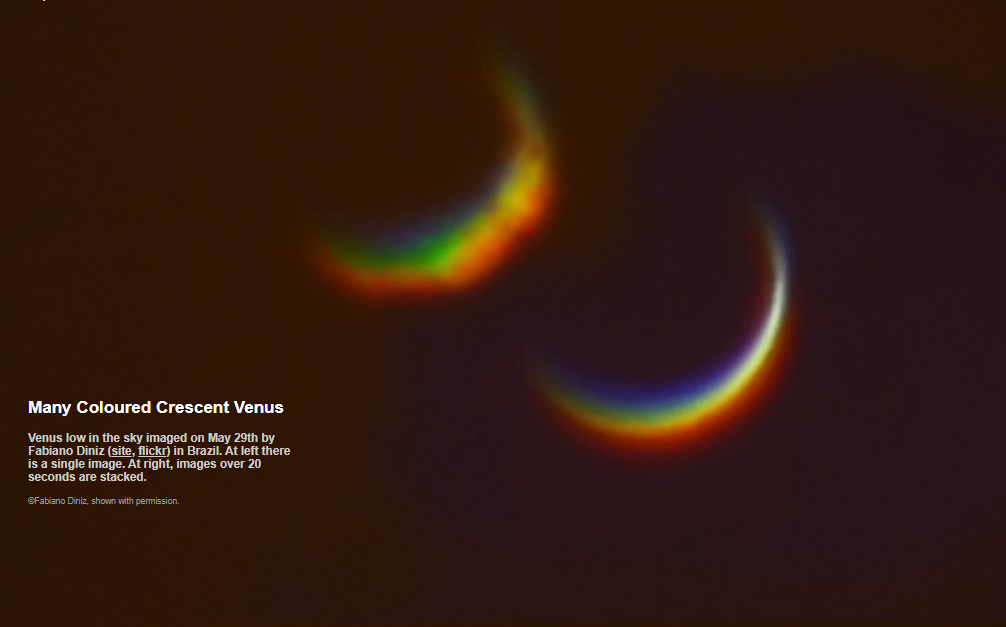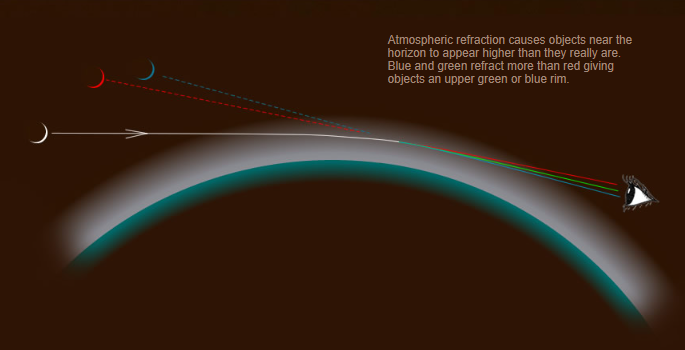OPOD - Many Coloured Venus
OPOD - Many Coloured Venus: Understanding Atmospheric Refraction
When observing celestial objects near the horizon, such as Venus, we often notice peculiar optical phenomena. One of these phenomena is the apparent displacement of objects, making them appear higher in the sky than they actually are. This intriguing effect is caused by atmospheric refraction, a phenomenon where light rays bend as they pass through Earth's atmosphere.
Atmospheric refraction occurs because the density of the air decreases with increasing altitude. As light passes from one medium (air) to another (vacuum), it changes speed and direction. When rays from objects near the horizon slant through the atmosphere, they encounter density gradients due to the denser air near the surface. As a result, these rays are refracted towards the denser air, bending them towards Earth's center.
The overall consequence of atmospheric refraction is that objects near the horizon appear higher than their true positions. However, this effect is not uniform across all colors of light. Different wavelengths of light experience varying degrees of refraction, leading to the phenomenon of color separation.
Blue and green light rays refract more than red light rays. Consequently, objects near the horizon often exhibit an upper green or blue rim. This colorful rim is a result of Earth's atmosphere interacting with the incoming light, creating a stunning visual display.
It is important to note that the colors observed in this phenomenon are not due to chromatic aberration artifacts in telescopes. Instead, they are genuinely produced by Earth's atmosphere. The scattering and refractive properties of the atmosphere give rise to these vibrant hues, enhancing our visual experience of celestial objects like Venus.
While red light rays are refracted the least, resulting in a less raised appearance, blue light is strongly scattered by the atmosphere. Therefore, it is common to observe an upper green rim around objects near the horizon. This green rim adds a captivating touch to our observations and highlights the intricate interplay between light and atmospheric conditions.
Although atmospheric refraction can produce stunning visual effects, it is important to differentiate it from the phenomenon of green or blue flashes. Green or blue flashes occur under specific mirage conditions that magnify the color separation caused by atmospheric refraction. These flashes are much rarer and require specific atmospheric conditions to manifest.
In conclusion, the many-colored Venus phenomenon, captured beautifully in the images by Fabiano Diniz, is a testament to the wonders of atmospheric optics. Atmospheric refraction causes objects near the horizon to appear higher than they actually are, with blue and green light rays refracting more than red light rays. This refraction creates upper green or blue rims around celestial objects, adding a touch of vibrancy to our observations. Understanding these optical phenomena enriches our appreciation of the natural world and the fascinating interplay between light and atmosphere.

Many Coloured Crescent Venus
Venus low in the sky imaged on May 29th by Fabiano Diniz (site, flickr) in Brazil. At left there is a single image. At right, images over 20 seconds are stacked.
©Fabiano Diniz, shown with permission.

Atmospheric refraction causes objects near the horizon to appear higher than they really are. Blue and green refract more than red giving objects an upper green or blue rim.
The colours are real in the sense of being produced by Earth's atmosphere rather than chromatic aberration artifacts in the telescope.
Rays from objects near the horizon slant through the atmosphere and encounter density gradients due to the air being more dense near to the surface. The rays are refracted towards the denser air, i.e. towards Earth's centre.
The overall effect is that objects near the horizon appear to be higher than they really are.
The effect is wavelength, colour, dependent. Red rays are refracted least and red images appear less raised than those in other colours. Stars, Venus, the Sun have a slight lower red rim. The upper limb can, as here, be blue but blue light is strongly scattered by the atmosphere and usually we have an upper green rim.
This is normal refraction. It is far too weak to give a green flash. Green or blue flashes rely on mirage conditions to magnify the colour separation.
Note: this article has been automatically converted from the old site and may not appear as intended. You can find the original article here.
Reference Atmospheric Optics
If you use any of the definitions, information, or data presented on Atmospheric Optics, please copy the link or reference below to properly credit us as the reference source. Thank you!
-
<a href="https://atoptics.co.uk/blog/opod-many-coloured-venus/">OPOD - Many Coloured Venus</a>
-
"OPOD - Many Coloured Venus". Atmospheric Optics. Accessed on December 28, 2024. https://atoptics.co.uk/blog/opod-many-coloured-venus/.
-
"OPOD - Many Coloured Venus". Atmospheric Optics, https://atoptics.co.uk/blog/opod-many-coloured-venus/. Accessed 28 December, 2024
-
OPOD - Many Coloured Venus. Atmospheric Optics. Retrieved from https://atoptics.co.uk/blog/opod-many-coloured-venus/.